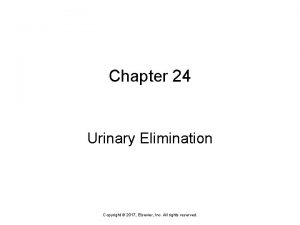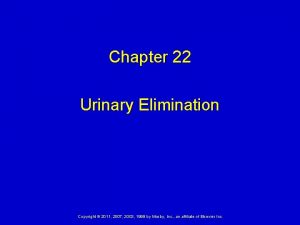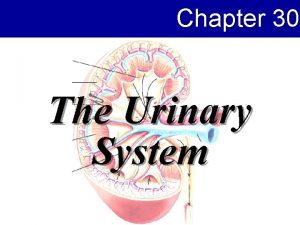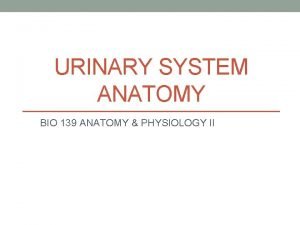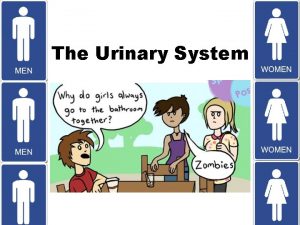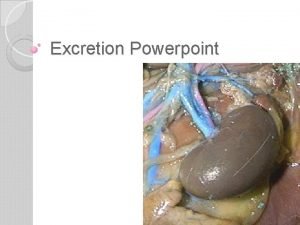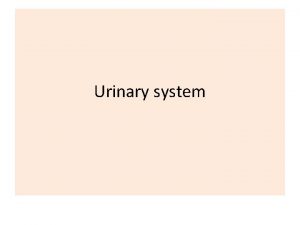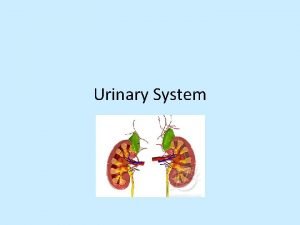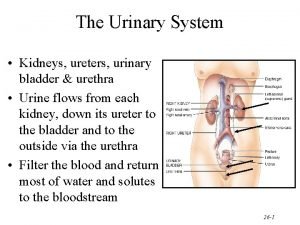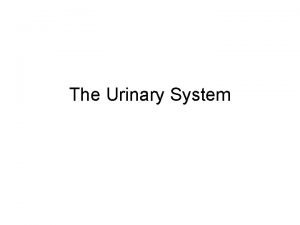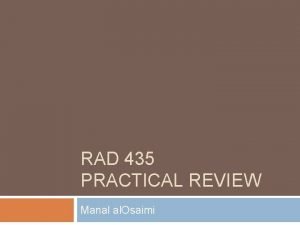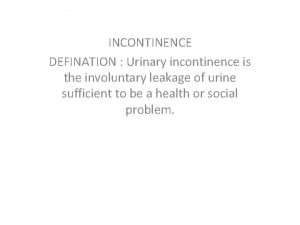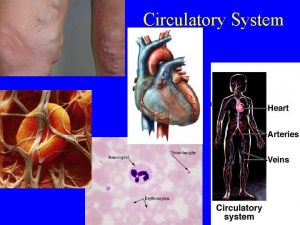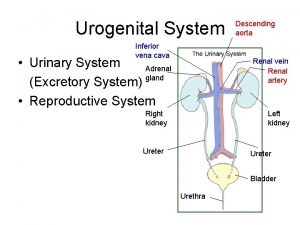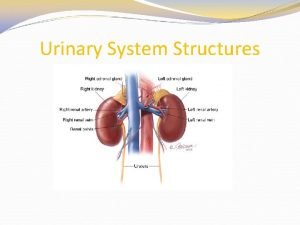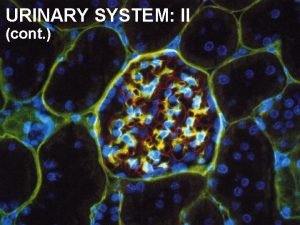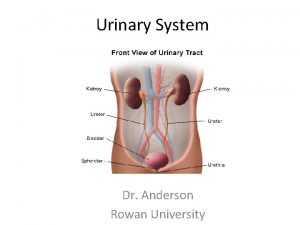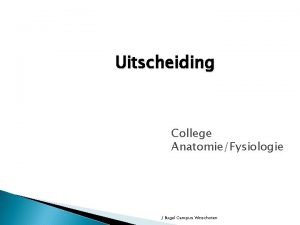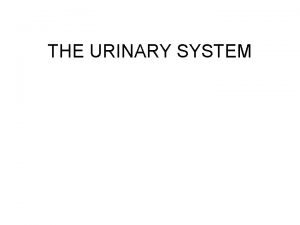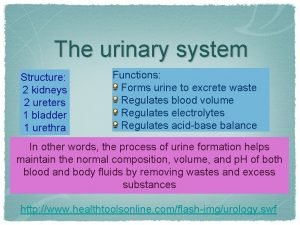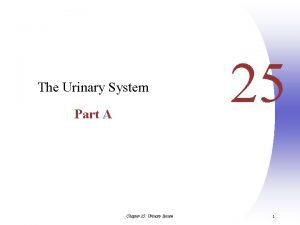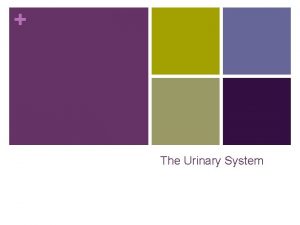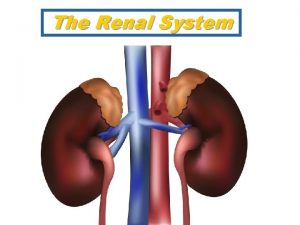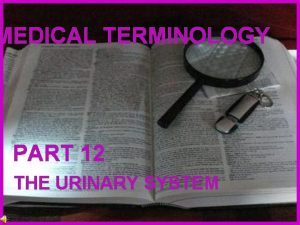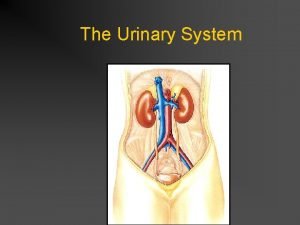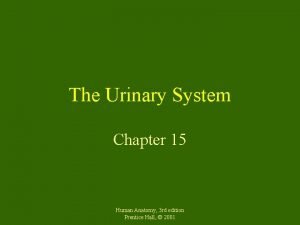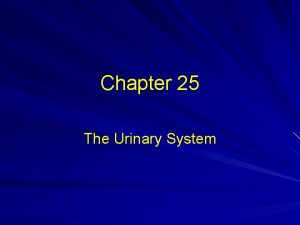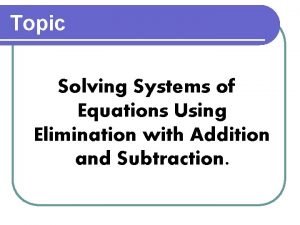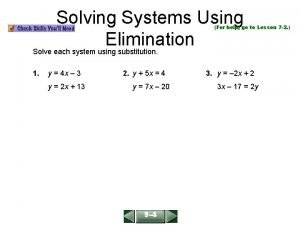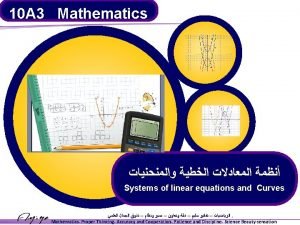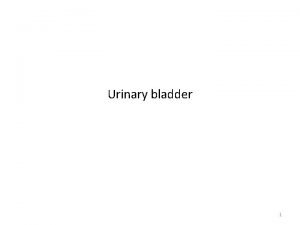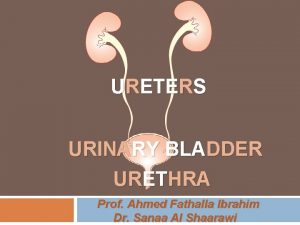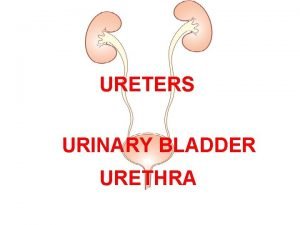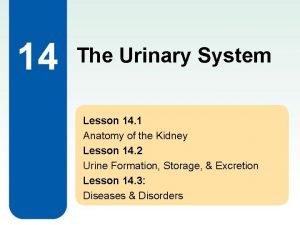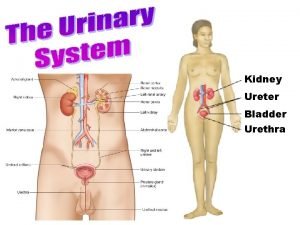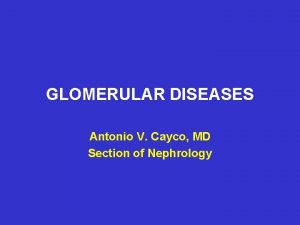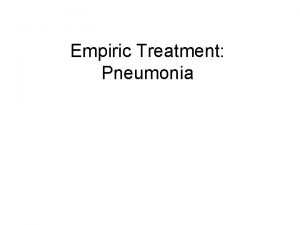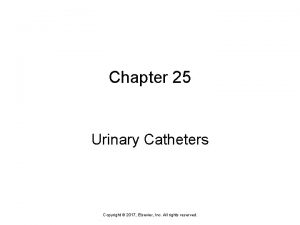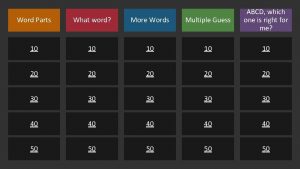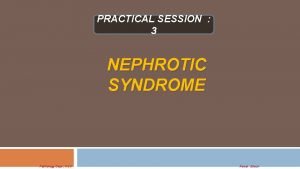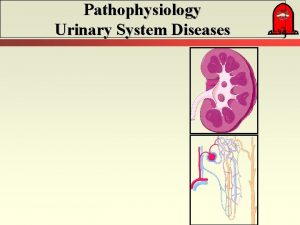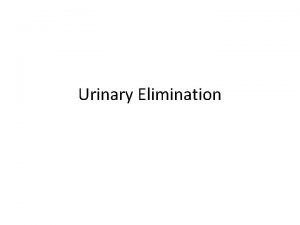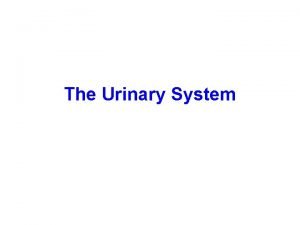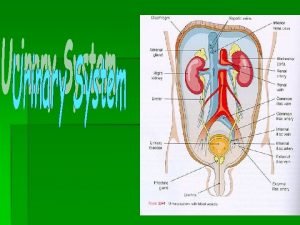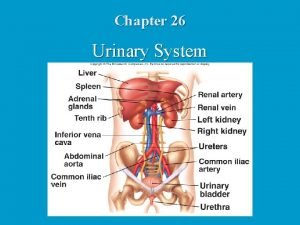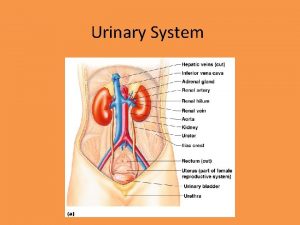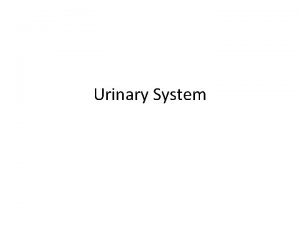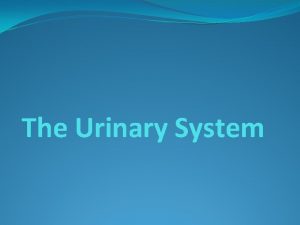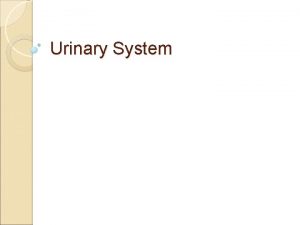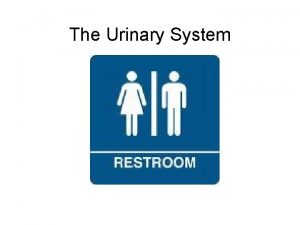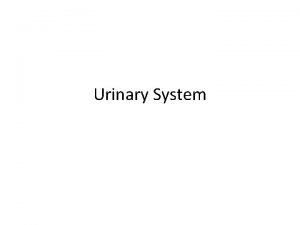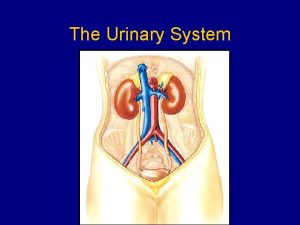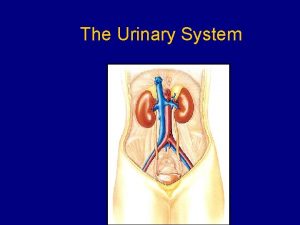Functions of the Urinary System Elimination of waste
































































- Slides: 64

Functions of the Urinary System • Elimination of waste products • Nitrogenous wastes • Toxins • Drugs

Functions of the Urinary System • Regulate aspects of homeostasis • Water balance • Electrolytes • Acid-base balance in the blood • Blood pressure • Red blood cell production • Activation of vitamin D

Organs of the Urinary System • Kidneys • Ureters • Urinary bladder • Urethra

Hepatic veins (cut) Inferior vena cava Adrenal gland Renal artery Renal hilum Aorta Renal vein Kidney Iliac crest Ureter Rectum (cut) Uterus (part of female reproductive system) Urinary bladder Urethra (a) Figure 15. 1 a

12 th rib (b) Figure 15. 1 b

Location of the Kidneys • Against the dorsal body wall in a retroperitoneal position (behind the parietal peritoneum) • At the level of the T 12 to L 3 vertebrae • The right kidney is slightly lower than the left (due to position of the liver)

Kidney Features • Renal hilum • A medial indentation where several structures enter or exit the kidney (ureters, renal blood vessels, and nerves) • An adrenal gland sits atop each kidney

Hepatic veins (cut) Inferior vena cava Adrenal gland Renal artery Renal hilum Aorta Renal vein Kidney Iliac crest Ureter Rectum (cut) Uterus (part of female reproductive system) Urinary bladder Urethra (a) Figure 15. 1 a

Coverings of the Kidneys • Fibrous capsule • Surrounds each kidney • Perirenal fat capsule • Surrounds the kidney and cushions against blows • Renal fascia • Outermost capsule that helps hold the kidney in place against the muscles of the trunk wall(Zookercandle fascia)

Regions of the Kidney • Renal cortex—outer region • Renal medulla—inside the cortex • Renal pelvis—inner collecting tube

Cortical radiate vein Cortical radiate artery Arcuate vein Arcuate artery Renal column Interlobar vein Interlobar artery Segmental arteries Renal cortex Renal vein Renal artery Minor calyx Renal pelvis Major calyx Renal pyramid Ureter Fibrous capsule (b) Figure 15. 2 b

Kidney Structures • Renal or medullary pyramids—triangular regions of tissue in the medulla • Renal columns—extensions of cortex-like material inward that separate the pyramids(like partitions) • Calyces—cup-shaped structures that funnel urine towards the renal pelvis at the tips of pyramids(papillae)

Renal column Major calyx Renal cortex Minor calyx Renal pyramid (a) Figure 15. 2 a

Blood Supply • Renal artery provides each kidney with arterial blood supply , they are branches of the Aorta • Renal artery divides into segmental arteries interlobar arteries arcuate arteries cortical arteries

Blood Supply • Venous blood flow, they drain into IVC • Cortical veins arcuate veins interlobar veins renal vein • There are no segmental veins

Figure 15. 2 c

Nephron Anatomy and Physiology • The structural and functional units of the kidneys, each kidney has one million nephrons • Responsible forming urine • Main structures of the nephrons • Glomerulus • Renal tubule

Cortical nephron Renal cortex Renal medulla Renal pelvis Fibrous capsule Collecting duct Renal cortex Proximal convoluted tubule Glomerulus Distal convoluted tubule Loop of Henle Ureter Renal medulla Juxtamedullary nephron (a) Figure 15. 3 a

Nephron Anatomy • Glomerulus • Knot of capillaries, from afferent arteriole • Glomerulus sits within a glomerular (Bowman’s) capsule (the first part of the renal tubule) • Inner layer of the capsule contains pores or slits for the filtrate to go.

PCT Glomerular capsular space Glomerular capillary covered by podocytes Efferent arteriole Afferent arteriole (c) Figure 15. 3 c

Filtration slits Podocyte cell body Foot processes (d) Figure 15. 3 d

Nephron Anatomy • Renal tubule extends from glomerular capsule and ends at the collecting duct • Glomerular (Bowman’s) capsule • Proximal convoluted tubule (PCT) • Loop of Henle • Distal convoluted tubule (DCT)

Proximal Peritubular convoluted Glomerular capillaries tubule (PCT) capillaries Distal convoluted tubule (DCT) Glomerular (Bowman’s) capsule Efferent arteriole Afferent arteriole Cells of the juxtaglomerular apparatus Cortical radiate artery Arcuate Cortical radiate vein Collecting duct (b) Loop of Henle Figure 15. 3 b

Types of Nephrons • Cortical nephrons • Located entirely in the cortex • Includes most nephrons • Juxtamedullary nephrons • Found at the boundary of the cortex and medulla

Cortical nephron Renal cortex Renal medulla Renal pelvis Fibrous capsule Collecting duct Renal cortex Proximal convoluted tubule Glomerulus Distal convoluted tubule Loop of Henle Ureter Renal medulla Juxtamedullary nephron (a) Figure 15. 3 a

Collecting Duct • Receives urine from many nephrons • Run through the medullary pyramids • Deliver urine into the calyces and renal pelvis

Proximal Peritubular convoluted Glomerular capillaries tubule (PCT) capillaries Distal convoluted tubule (DCT) Glomerular (Bowman’s) capsule Efferent arteriole Afferent arteriole Cells of the juxtaglomerular apparatus Cortical radiate artery Arcuate Cortical radiate vein Collecting duct (b) Loop of Henle Figure 15. 3 b

Nephron Anatomy • Nephrons are associated with two capillary beds • Glomerulus • Peritubular capillary bed

Glomerulus • Fed and drained by arterioles • Afferent arteriole—arises from a cortical artery and feeds the glomerulus • Efferent arteriole—receives blood that has passed through the glomerulus • Specialized for filtration • High pressure forces fluid and solutes out of blood and into the glomerular capsule due to difference in diameter in the afferent & efferent arteriole , it is almost equal to the blood pressure 100 mm/hg

PCT Glomerular capsular space Glomerular capillary covered by podocytes Efferent arteriole Afferent arteriole (c) Figure 15. 3 c

Afferent arteriole Glomerular capillaries Efferent arteriole Cortical radiate artery 1 Glomerular capsule Rest of renal tubule containing filtrate 2 Peritubular capillary 3 To cortical radiate vein Three major renal processes: 1 2 3 Urine Glomerular filtration: Water and solutes smaller than proteins are forced through the capillary walls and pores of the glomerular capsule into the renal tubule. Tubular reabsorption: Water, glucose, amino acids, and needed ions are transported out of the filtrate into the tubule cells and then enter the capillary blood. Tubular secretion: H+, K+, creatinine, and drugs are removed from the peritubular blood and secreted by the tubule cells into the filtrate. Figure 15. 4

Peritubular Capillary Beds • Arise from efferent arteriole of the glomerulus • Normal, low pressure capillaries • Adapted for absorption instead of filtration • Placed close to the renal tubule to reabsorb some substances from collecting tubes

Proximal Peritubular convoluted Glomerular capillaries tubule (PCT) capillaries Distal convoluted tubule (DCT) Glomerular (Bowman’s) capsule Efferent arteriole Afferent arteriole Cells of the juxtaglomerular apparatus Cortical radiate artery Arcuate Cortical radiate vein Collecting duct (b) Loop of Henle Figure 15. 3 b

Functions of kidney • Glomerular filtration • Tubular reabsorption • Tubular secretion

Afferent arteriole Glomerular capillaries Efferent arteriole Cortical radiate artery 1 Glomerular capsule Rest of renal tubule containing filtrate 2 Peritubular capillary 3 To cortical radiate vein Three major renal processes: 1 2 3 Urine Glomerular filtration: Water and solutes smaller than proteins are forced through the capillary walls and pores of the glomerular capsule into the renal tubule. Tubular reabsorption: Water, glucose, amino acids, and needed ions are transported out of the filtrate into the tubule cells and then enter the capillary blood. Tubular secretion: H+, K+, creatinine, and drugs are removed from the peritubular blood and secreted by the tubule cells into the filtrate. Figure 15. 4

Glomerular Filtration • Nonselective passive process • Water and solutes smaller than proteins are forced through capillary walls • Proteins and blood cells are normally too large to pass through the filtration membrane • Filtrate is collected in the glomerular capsule and leaves via the renal tubule

Tubular Reabsorption • The peritubular capillaries reabsorb useful substances • Water • Glucose • Amino acids • Ions • Some reabsorption is passive, most is active • Most reabsorption occurs in the proximal convoluted tubule

Proximal tubule Glomerular HCO 3– Glucose and capsule Na. Cl H 2 O amino acids Distal tubule Na. Cl Blood Filtrate H 2 O Salts (Na. Cl, etc. ) HCO 3– (bicarbonate) H+ Urea Glucose; amino acids Some drugs Reabsorption Active transport Passive transport Secretion (active transport) K+ and some drugs Some drugs H+ and poisons Cortex Collecting duct Medulla Loop of Henle H 2 O Na. Cl H 2 O K+ Na. Cl Urea H 2 O Urine (to renal pelvis) Figure 15. 5

Tubular Reabsorption • What materials are not reabsorbed? • Nitrogenous waste products • Urea—protein breakdown • Uric acid—nucleic acid breakdown • Creatinine—associated with creatine metabolism in muscles

Tubular Secretion: Reabsorption in Reverse • Some materials move from the blood of the peritubular capillaries into the renal tubules • Hydrogen and potassium ions • Creatinine • Process is important for getting rid of substances not already in the filtrate • Materials left in the renal tubule move toward the ureter

Proximal tubule Glomerular HCO 3– Glucose and capsule Na. Cl H 2 O amino acids Distal tubule Na. Cl Blood Filtrate H 2 O Salts (Na. Cl, etc. ) HCO 3– (bicarbonate) H+ Urea Glucose; amino acids Some drugs Reabsorption Active transport Passive transport Secretion (active transport) K+ and some drugs Some drugs H+ and poisons Cortex Collecting duct Medulla Loop of Henle H 2 O Na. Cl H 2 O K+ Na. Cl Urea H 2 O Urine (to renal pelvis) Figure 15. 5

Characteristics of Urine • In 24 hours, about 1. 0 to 1. 8 liters of urine are produced • Urine and filtrate are different • Filtrate contains everything that blood plasma does (except proteins) • Urine is what remains after the filtrate has lost most of its water, nutrients, and necessary ions through reabsorption • Urine contains nitrogenous wastes and substances that are not needed

Characteristics of Urine • Yellow amber color due to the pigment urochrome (from the destruction of hemoglobin) and solutes • Dilute urine is a pale, straw color • Sterile • Slightly aromatic • Normal p. H of around 6 • Specific gravity of 1. 001(less than means dilute urine) to 1. 035(higher than it means conc. Urine)

Characteristics of Urine • Solutes normally found in urine • Sodium and potassium ions • Urea, uric acid, creatinine • Ammonia • Bicarbonate ions

Characteristics of Urine • Solutes NOT normally found in urine • Glucose • Blood proteins • Red blood cells • Hemoglobin • White blood cells (pus) • Bile

Abnormal Urine Constituents Substance Name of Condition Possible Causes Glucose Glucosuria Excess sugary intake; diabetes mellitus Proteinuria Physical exertion, pregnancy; glomerulonephritis, hypertension Pus (WBCs and bacteria) Pyuria Urinary tract infection RBCs Hematuria Bleeding in the urinary tract Hemoglobinuria Various: transfusion reaction, hemolytic anemia Bile pigments Bilirubinuria Liver disease (hepatitis)

Signs and Symptoms of Urinary Tract. Disease • Crystalluria – Crystals in Urine • Stones in Urinary Tract • Renal Colic – Pain from: • Male: Loin to Testes • Female: Loin to Labia • Dysuria(Pain when Urinating) • Frequency

Types of Renal Calculi (Kidney Stones) • Phosphate Stones • Present in case of severe infection • Urate Stones • Uric Acid • Pigmented Stones • Dark red due to internal bleeding in the urinary tract • Xanthin Stone • Made of Coffee Granules • Mixed Stone • Any combination of the above stones

Ureters • Slender tubes attaching the kidney to the bladder • Continuous with the renal pelvis • Enter the posterior aspect of the bladder into the upper 2 angles of the trigone • Runs behind the peritoneum • Peristalsis aids gravity in urine transport

Hepatic veins (cut) Inferior vena cava Adrenal gland Renal artery Renal hilum Aorta Renal vein Kidney Iliac crest Ureter Rectum (cut) Uterus (part of female reproductive system) Urinary bladder Urethra (a) Figure 15. 1 a

Urinary bladder Ureteral orifice External urethral sphincter Urogenital diaphragm Trigone Internal urethral orifice Internal urethral sphincter Urethra Figure 15. 6

Urinary Bladder • Smooth, collapsible, muscular sac • Temporarily stores urine • Trigone—triangular region of the bladder base • Three openings • Two from the ureters • One to the urethra • In males, the prostate gland surrounds the neck of the bladder

Urinary bladder Ureteral orifice External urethral sphincter Urogenital diaphragm Trigone Internal urethral orifice Internal urethral sphincter Urethra Figure 15. 6

Urinary Bladder Wall • Three layers of smooth muscle collectively called the detrusor muscle • Mucosa made of transitional epithelium • Walls are thick and folded in an empty bladder, rugae. • Bladder can expand significantly without increasing internal pressure

Urinary Bladder Capacity • A moderately full bladder is about 5 inches long and holds about 500 m. L of urine • Capable of holding twice that amount of urine

Umbilicus Superior wall of distended bladder Superior wall of empty bladder Pubic symphysis Figure 15. 7

Urethra • Thin-walled tube that carries urine from the bladder to the outside of the body by peristalsis • Release of urine is controlled by two sphincters • Internal urethral sphincter • Involuntary and made of smooth muscle • External urethral sphincter • Voluntary and made of skeletal muscle

Urinary bladder Ureteral orifice External urethral sphincter Urogenital diaphragm Trigone Internal urethral orifice Internal urethral sphincter Urethra Figure 15. 6

Urethra Gender Differences • Length • Females is 3 to 4 cm (1 inch) • Males is 20 cm (8 inches) • Location • Females—anterior to the vaginal opening • Males—travels through the prostate and penis • Prostatic urethra • Membranous urethra • Spongy urethra(penile urethera)

Urethra Gender Differences • Function • Females—only carries urine • Males—carries urine and is a passageway for sperm cells and semen

Micturition (Voiding) • Both sphincter muscles must open to allow voiding • The internal urethral sphincter is relaxed after stretching of the bladder • Pelvic splanchnic nerves initiate bladder to go into reflex contractions • Urine is forced past the internal urethra sphincter and the person feels the urge to void • The external urethral sphincter must be voluntarily relaxed to void

• Urinary infections are the only common problems before old age • Escherichia coli (E. coli), a type of bacteria, accounts for 80 percent of UTI (urinary tract infections)

Aging and the Urinary System • There is a progressive decline in urinary function • The bladder shrinks and loses bladder tone with aging

Aging and the Urinary System • Associated problems with aging • Urgency—feeling that it is necessary to void • Frequency—frequent voiding of small amounts of urine • Nocturia—need to get up during the night to urinate • Incontinence—loss of control • Urinary retention—common in males, often the result of hypertrophy of the prostate gland
 Chapter 22 urinary elimination
Chapter 22 urinary elimination Chapter 24 urinary elimination
Chapter 24 urinary elimination Chapter 22 urinary elimination
Chapter 22 urinary elimination Impaired urinary elimination
Impaired urinary elimination Alteration in urinary elimination
Alteration in urinary elimination Gaussian elimination and gauss-jordan elimination
Gaussian elimination and gauss-jordan elimination Lymphatic system and urinary system
Lymphatic system and urinary system Urinary system introduction
Urinary system introduction Chapter 15 urinary system
Chapter 15 urinary system Pyelo medical terminology
Pyelo medical terminology Interesting facts about the urinary system
Interesting facts about the urinary system Urogenital papilla fetal pig
Urogenital papilla fetal pig The urinary system chapter 30
The urinary system chapter 30 Kidney pyramid labeled
Kidney pyramid labeled Chapter 20 urinary/excretory system
Chapter 20 urinary/excretory system Urinary system model
Urinary system model Urinary system fun fact
Urinary system fun fact Fish urinary system
Fish urinary system Urinary system powerpoint
Urinary system powerpoint Renal system
Renal system Urinary system pathway
Urinary system pathway Renal corpuscle
Renal corpuscle Figure 15-4 is a diagram of a nephron
Figure 15-4 is a diagram of a nephron Spill of dye
Spill of dye Defination of urine
Defination of urine Excretory system
Excretory system Endocrine glands of rat
Endocrine glands of rat Rat urinary system
Rat urinary system Vena cava urinary system
Vena cava urinary system Figure 15-3 the urinary system
Figure 15-3 the urinary system Medullary rays
Medullary rays Renal tubule
Renal tubule Urinary system
Urinary system Flow of urine diagram
Flow of urine diagram What is this called
What is this called Normal and abnormal constituents of urine
Normal and abnormal constituents of urine Peritubular capillaries
Peritubular capillaries Kidney
Kidney Urinary system root words
Urinary system root words Renal lobe and lobule
Renal lobe and lobule Arneriole
Arneriole Youtube urinary system
Youtube urinary system The urinary system chapter 15
The urinary system chapter 15 Anatomical structure of urinary system
Anatomical structure of urinary system Chapter 9 the urinary system labeling exercises
Chapter 9 the urinary system labeling exercises Afferent arteriole and efferent arteriole
Afferent arteriole and efferent arteriole Solve a system of equations using elimination
Solve a system of equations using elimination Solve each system by elimination
Solve each system by elimination Solve a system of equations using elimination
Solve a system of equations using elimination 7:x2+(y-3√x2)2=1
7:x2+(y-3√x2)2=1 Urinary bladder apex and base
Urinary bladder apex and base Length of male urethra
Length of male urethra Ureter constrictions
Ureter constrictions Infrolateralt
Infrolateralt Cvc care bundle checklist
Cvc care bundle checklist Lesson 14.2 male and female urinary structures
Lesson 14.2 male and female urinary structures ç
ç What is the function of the bladder
What is the function of the bladder Urinary bladder
Urinary bladder Uti
Uti Complicated urinary tract infection
Complicated urinary tract infection Chapter 25 urinary catheters
Chapter 25 urinary catheters _____ is difficulty in starting a urinary stream.
_____ is difficulty in starting a urinary stream. Carcinoma
Carcinoma Urinary tract obstruction
Urinary tract obstruction

